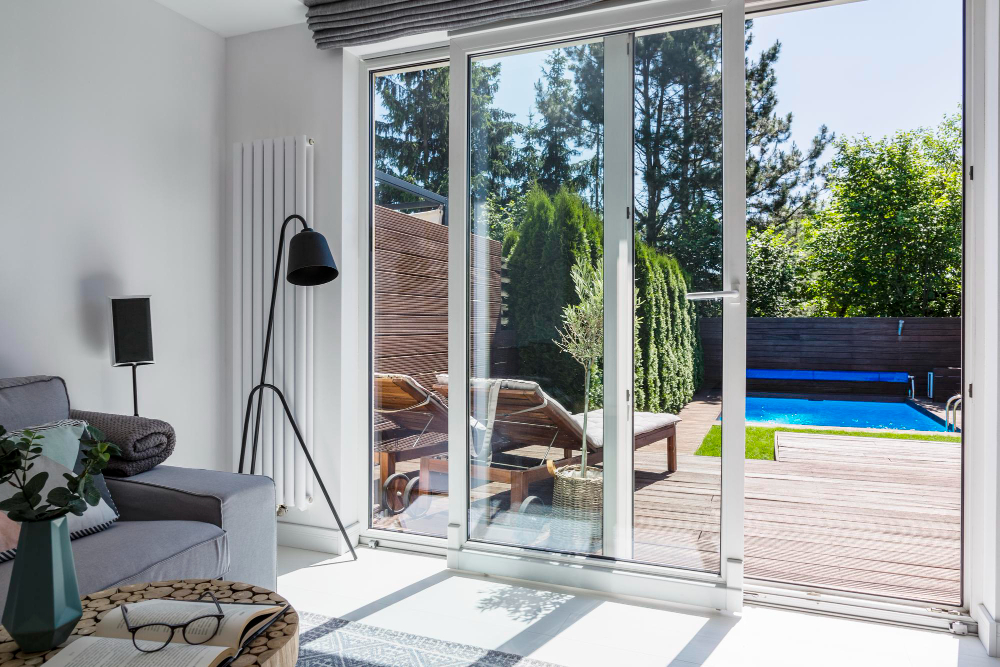
It is worth knowing a little about sliding patio door sizes to make an ideal choice regarding new doors for your property’s extension. The size of your new sliding doors helps provide the best comfort and adequate light during winter. Moreover, you will want them to function well summer season too. Therefore, it is important to consider sliding glass door sizes carefully when designing or updating your space. They are available in various dimensions to suit different styles and functional requirements. This helps in selecting the appropriate fit, whether seeking a standard size or a custom solution.
You can choose sliding glass doors of any size that fit your space, from standard patio doors to large glass panels that go from floor to ceiling. This guide will help you choose the perfect sliding glass door, including standard sizes and customization options. Let’s delve into the various dimensions offered and practical advice to ensure you make the optimal decision for your project.
Dimensions of Standard Sliding Glass Doors
The standard sliding glass door size can differ based on your preferences and requirements. Most doors are 80 to 96 inches tall, based on the height of your property’s ceiling. The width typically ranges from 60 to 192 inches, based on how many glass panels you select.
When replacing an old door, the standard size is likely around 80 inches wide. Even small differences in size can affect your installation, so it is necessary to measure your space carefully. Understanding your options can also help you keep the expenses associated with installing your patio door to a minimum.
| Standard Two-Panel Sliding Glass Door Sizes | Standard Three-Panel Sliding Glass Door Sizes | Standard Four-Panel Sliding Glass Door Sizes | |||
| Width | Height | Width | Height | Width | Height |
| 60” | 82” | 108” | 80” | 144” | 80” |
| 60” | 82” | 108” | 82” | 192” | 80” |
| 60” | 96” | 108” | 96” | 144” | 82” |
| 72” | 80” | 144” | 80” | 192” | 82” |
| 72” | 82” | 144” | 82” | 144” | 96” |
| 72” | 96” | 144” | 96” | 192” | 96” |
| 96” | 80” | ||||
| 96” | 82” | ||||
| 96” | 96” | ||||
Sliding Glass Door Sizes for Patios
Various factors must be considered when selecting sliding glass door sizes for patios to ensure the perfect fit for your property. Standard sizes are available, but custom sizes can also match your requirements. The height of a standard sliding glass door is consistent, yet the width can vary based on the number of panels you use. You can select from two-panel, three-panel, or even four-panel configurations.
Considering the nearby obstacles or structures, measuring the opening area accurately is crucial. Additionally, the more glass panels you use, the more daylight will likely enter your space, allowing you to enjoy beautiful outdoor scenery.
Two-Panel Sliding Glass Door Sizes
As the most popular sliding glass door, standard two-panel sliding glass doors have a typical height of 80 – 90 inches and widths of 60, 72, or 96 inches (5, 6, or 8 feet).
Panel Configuration: A two-panel sliding door contains two glass panels that slide along a track, with one non-moveable panel.
Three-Panel Sliding Glass Door Sizes
Ideal for proprietors who require a large opening to their property’s exterior part, these types of glass doors typically measure 108, 120, or 144 inches in width and are 6 to 8 feet 80 inches or 96 inches in height.
Panel Configuration: Three-panel doors feature one fixed panel and two sliding panels that move along a track.
Four-Panel Sliding Glass Door Sizes
Four-panel sliding glass doors provide a larger opening area and are a great way to showcase your freshly repaired patio deck. They have 144 or 192 inches (12 or 16 feet) widths and heights between 80 and 96 inches, offering a wide opening and view.
Panel Configuration: A four-panel sliding glass door comprises two sliding panels on either side of two stationary panels.
When Do You Require Custom Sliding Glass Door Sizes?
You must choose custom sliding glass door sizes when standard sizes don’t fit your opening or your space has an unusual shape or design requirements. You can select custom sliding glass doors for a variety of reasons:
Non-Standard Openings
If your opening is too wide, narrow, tall, or short for standard sliding glass door sizes, you will need custom doors.
Unusual Shapes or Designs
Custom sizes are essential if your opening is curved or angled or has specific design requirements that standard doors cannot meet.
Bespoke Solutions
Custom sliding glass doors are ideal for accomplishing a seamless fit and maximizing the attractiveness of your space, especially when you want to match particular architectural features or design preferences.
When measuring for custom doors, remember to measure the brickwork opening outside the property, always in millimeters (mm). If you are unsure whether you need custom doors or have any questions about sizing or design, consult a specialist or glasswork firm.
Factors to Consider When Selecting a Sliding Glass Door
Choosing the correct size for a sliding glass door involves taking both design and practicality into account. Here are some important tips to consider when selecting a sliding glass door for your home:
- Determine Your Space Requirements: Measure the opening precisely, considering both width and height, and factor in the number of required panels.
- Assess the Quality of the Glass: For better insulation and energy efficiency, choose double or triple-paned glass having low-E coatings.
- Consider the Frame Material: You can choose from timber, aluminum, or uPVC, evaluating their respective pros and cons regarding durability, aesthetics, and cost.
- Pay Attention to Security Features: Search for strong frames and several locking points, and consider security glass for improved protection.
- Evaluate Energy Efficiency: Prioritize doors with low U-values and good insulation, and consider features like weatherstripping for optimal energy performance.
- Test the Door’s Functionality: Ensure the door slides smoothly and easily, and check the operation of the locking mechanism.
- Think About Maintenance: Consider the convenience of cleaning and maintaining of the frame material and glass and the door’s lifespan.
- Consider the Style and Design: Choose a style that complements your home’s aesthetics, and consider features like different panel layouts or color options.
- Factor in Your Budget: Compare prices from different contractors and consider the long-term cost of ownership, which include maintenance and energy bills.
- Check for Warranties: Ensure the door has a comprehensive warranty, and look for insurance-backed warranties for added peace of mind.


